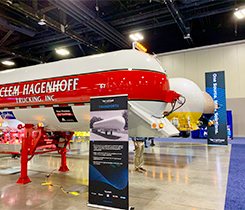High cost of tanks forces propane marketers to better manage purchases, placement
As the cost of steel keeps going up, with propane-tank pricing bursting at the seams, marketers are facing a conundrum when trying to save money on LPG delivery by making fewer runs and installing larger vessels at accounts drawing heftier loads.
 |
“It benefits me to put bigger tanks in there because we can get more storage at the customer’s location,” explains Chris Stanley, vice president of Euliss Propane in Liberty, N.C. “When I go out to set a tank, I’m looking at the highest capacity I can get because that’s increasing my storage at the customer’s site.”
A bigger tank in a customer’s back yard not only lessens a marketer’s onsite storage needs and winter bottleneck issues at the terminals, but it also cuts costly diesel fuel consumption by lowering the amount of deliveries and late-night, out-of-gas calls, he says.
Yet this strategy is made more difficult with propane tanks becoming so expensive, according to Stanley, who sees a significant impact throughout the industry. “The big multi-staters are setting fewer tanks, and there are a lot of used tanks on the market now,” he says.
 Marketers would prefer to lessen their onsite storage needs by installing larger tanks at the customer’s location. Increasing steel prices have affected this strategy. |
AmeriGas has “drastically” decreased its new-tank purchases because of the pricing increases, opting instead to shift its current supply. “Rather than buying a new one, we’ll have it shipped from another location,” says James Marshall, director of procurement. “Like most of the majors, we have plenty of tanks laying about our districts. We identify pockets of excess tanks and we move them to locations that are in need of tanks.”
As a company dealing with thousands of tanks, “we’ve saved several million dollars in capital expenditures with this program,” reports Marshall, citing an ongoing effort to more effectively utilize its available stock of vessels.
“It’s an expense that needs to be managed carefully,” he points out. “When we have to buy them, we have to buy them – but we’re looking to clean up our yards and refurbish what we have when it makes sense.” An in-house staff handles refurbishment duties rather than a third-party provider of this service.
Euliss Propane prefers to buy its tanks new. However, Stanley is reviewing his purchasing patterns because he remains intent on fitting his larger-load customers with tank sizes reflecting their actual usage patterns to help put the brakes on skyrocketing diesel-driven delivery costs. “You can buy a reconditioned 500-gallon tank with the gauges for the same price as a new 325-gallon tank,” he observes. “I haven’t done it yet, but I’m definitely considering it.”
 Pain at the pump a plus for 20-pounders? |
Relentless escalation
“We have seen a downturn in new tanks; our pre-owned tank market has seen a major upswing,” notes Ted Reilly, vice president of sales and marketing for American Welding & Tank (AWT). In May the company enacted a 7.5 percent price increase on new tanks plus a 3.5 percent transportation surcharge. Pricing for its lines of refurbished and used tanks rose to 3 percent in addition to the 3.5 percent hauling fee.
Depending on tank size, AWT has implemented increases ranging from 22 percent to 26 percent since January. “Steel price increases influenced by sustained global demand, rising steel scrap costs and energy surcharges passed through from the mills are forecast to continue throughout 2008,” says Reilly, anticipating slackening tank demand when the usually busy fall buying season arrives.
Orders were coming in earlier this summer in an effort to beat the rising rates. “The propane marketers have been looking to purchase their needs before the increases,” Reilly recounts, acknowledging the financial stresses involved in the situation. “This is having a constraint on capital growth. They’re growing at a lower per-unit rate because they only have so many dollars to invest in their growth – they have to cut back on the number of units that they buy.”
 steel prices |
In an effort to ease the associated economic woes, the company offers its customers used tanks “as an alternative to the relentless escalation in the cost of new tanks,” he says.
“AWT launched its tank refurbishing service and pre-owned tank program to reduce the propane marketers’ tank costs to levels that are competitive with other alternative fuels,” adds Reilly, referring to concerns that consumers may switch to an all-electric utility connection. “The refurbishing and conversion services are an ideal fit for the propane marketer who has idle tanks in inventory.”
A seller’s market
A “perfect storm” has struck the domestic steel user’s marketplace, according to Dusty McClintock, vice president of sales and marketing at Worthington Cylinders, which has enacted four price increases totaling 31 percent since the beginning of the year. The latest announcement in April amounted to a 6 percent to 8 percent boost.
“It certainly has had an impact on the business,” McClintock says. “The good thing for us is that it’s not an isolated problem; it’s a well-known industry issue.”
He goes on to note how “we’re educating our customers. The steel industry is doing what the oil industry is doing: It’s a seller’s market.”
There are no signs of stabilization in sight. “My cylinders today are going to be cheaper than they are next month. There’s a shock factor with the price and there’s also a fear factor that it could get worse,” muses McClintock, encouraging potential purchasers to adopt the position of “if we don’t buy now, it’s going to be more expensive in the future.”
A number of complexities are in play, he says. “The U.S. steel market, though at record levels, is still lower than the balance of the world.” Because the American dollar is weak and demand is so high in India, China and elsewhere, global producers can make more money by selling overseas and there is little motivation to push sales in the U.S. “We’re paying a lot more for steel in Europe than we are in the United States,” he says.
Foreign steel operations have increased scrap consumption by 25 percent over the past year, thus driving American scrap exports to record levels and leaving less availability for the domestic mills. Also, the three top steelmakers in the United States control 70 percent of the flat rolled industry.
And all of this puts pressure on tank producers. “Despite our efforts to contain costs, the steel mills continue to regularly and dramatically advance prices and have significantly impacted the company’s costs,” says McClintock. “We continue to see unprecedented increases in steel and aluminum cost, making it necessary for us to pass on an increase to the market.”
















